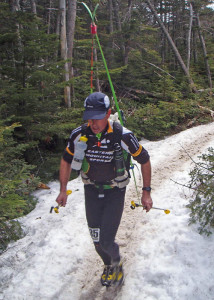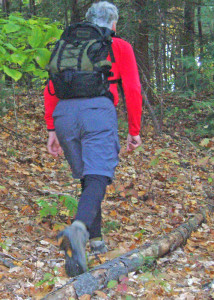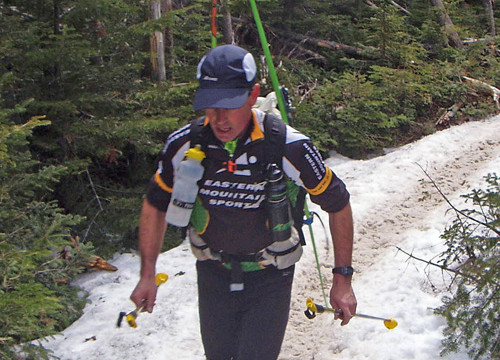
Good Base Layers Make Happy Homeotherms
Human beings are homeotherms, which is a fancy way to say we are warm-blooded creatures who function best at a more or less constant body temperature. Dressing for any active outdoor pastime, therefore, is always a balancing act between staying warm and staying cool. If you’re cold you can’t perform well.—and won’t enjoy what you’re doing. On the other hand, overheating isn’t high on anyone’s comfort scale, either. Working up a light sweat is one thing, being completely drenched is another.
And the worst-case scenario is when you overheat and sweat profusely while you’re active, then freeze when you stop moving. It’s not so bad if you’re out for a quick hike or bike ride then returning to a warm shower. But if you’re out for the whole day, or several days in a row, that roast/freeze cycle can get pretty darned uncomfortable.
So the eternal quest is to be warm, but not hot; cool, but not cold. That’s in a climate where the temperature may start out well below freezing in the morning and climb to 70 by mid afternoon. Welcome to the northeast!

Fortunately, modern clothing make it easier than ever before to maintain your cool (or your warm). Probably the single most often given piece of outdoor advice is to “Dress In Layers.” You hear it from everyone (including me!) and it’s the best advice you’ll ever get—but only if you dress in the right layers.
The single most important layer for your comfort is long underwear base layers that touches your skin. How well it handles moisture—both the sweat you generate and any precipitation that might penetrate from the outside—will largely determine how comfortable you are.
For most situations, lightweight polyester underwear next to your skin is a good choice. The lightest versions are sometimes called “silkweight” or “runner’s weight,” and these are the ones to look for. Polyester fibers are a great choice because they don’t absorb water. Instead they provide surfaces that tends to move moisture away from your skin, particularly when you are warmer than the surrounding environments—your own body heat acts as a clothes dryer.
There are lots of different high quality underwear choices on the market. I’ve used polyester tops and bottoms from Hot Chillys, Marmot, The North Face, Patagonia, and EMS. As far as I can tell, brand doesn’t matter nearly as much the quality of the workmanship and the fit.

Personally, I like slightly stretchy versions that stay snug against the skin as opposed to looser fitting options (which can bunch under other layers). For active sports like hiking, and biking, and winter sports like cross-country skiing, and snowshoeing, I like very lightweight long underwear bottoms (which I’ll often wear under a pair of shorts during high-aerobic activity), and a lightweight, long-sleeve, zip-neck top—which can be worn with the neck zipped open and the sleeves pushed up to vent excess heat. Unfortunately, it’s hard to find zip-neck in fabrics that are light enough, so crew neck is usually your only option.
The reason to choose the lightest base layer you can (and one that fits snugly without restricting circulation) is that in very cold weather, you can then throw another, heavier layer of long underwear over it for lots of warmth with little weight and bulk. That’s when you’ll wear your zip-neck.
Add more or thicker insulation layers as needed for your activity level, top it all off with a waterproof/windproof/breathable shell (the second most important layer) and you’re good to go as fast and far and long as you like in any weather. For tips on these layers, go here. And if you think that losing most of your heat through your head is a myth, read this.
But it’s that first layer, the one right next to your skin that’s going to have the most impact as you play outdoors this fall and through the coming winter. Make sure you choose wisely. Oh, and try to get out often enough to occasionally wear out a set of longies.
Base Layers: Dress Like A Sheep (They Stay warm, And You Will, Too)
There’s been a revolution in recent years as companies have developed lightweight wool underwear that doesn’t itch. If you want a natural fiber next to your skin, wool is your only choice for performance underwear. In my experience, silk just plain doesn’t work very well, and cotton is hypothermia waiting to happen. There have been some supposedly “dry cotton” fabrics developed, but I’m not ready to trust my life to them.
Though wool absorbs more moisture than polyester, it still works beautifully. In fact, wool is my first choice for multi-day backcountry trips. The secret to wool underwear is the slightly fuzzy inner surface which dries quickly and always keeps pulling moisture away from your skin.
In the olden days, hard-core outdoors folks who didn’t have a lot of money spent what they had on wool long john bottoms, then prowled thrift stores for lightweight, soft (merino or cashmere preferred) wool sweaters to wear as underwear tops. We’d look for extra large and boil them to shrink and tighten the weave. I had a lovely soft pink cashmere number that must have been made for a a much larger person. Boiled, it shrank to about half its original size and I wore it until it literally disintegrated. Wool has come a long way since those days . . .
Smart Wool, Icebreaker, Ibex, Minus 33 and others make merino wool long underwear in a variety of weights. It’s easy to take care of and works extremely well—though it’s generally a lot more expensive than polyester.
Base Layers: Cotton Chills
Because it absorbs moisture like a sponge, and hold onto it, cotton is the worst choice for outdoor apparel in cold, potentially wet climates. Especially don’t wear it next to your skin! If you sweat even a little or it rains even a little cotton quickly gets soaked and loses whatever insulation value it had when dry. There’s no faster way to get chilled . . .
Please, please, please don’t head outdoors wearing a cotton t-shirt and bluejeans. Even in summer, the weather can turn in an instant putting you at risk for discomfort at best, hypothermia at worst.



[…] covered (pardon the pun) the subject of dressing properly for outdoor activity, with advice on base underwear layers, insulation and shell garments, and keeping head, hands and feet warm […]
[…] you read last week’s column, you know that choosing the right long underwear can make all the difference in your comfort level […]
[…] feedback from readers on my recent columns on dressing properly in insulation and outer shells and long underwear for outdoor fun. Most of it has been positive, though a few folks seem to think that I’m strange […]
[…] in layers—but it helps if you have the right layers: Always start with an ultrathin layer of lightweight wicking underwear—wool or polyester–tops and bottoms next to your skin. That way, even if you sweat (in a […]
[…] Long underwear (Polyester or wool not cotton ) […]
[…] it’s cold, you WILL sweat, so having layers that can breathe is important. Make sure your base layer wicks. Wear less than you think you’ll need, as long as what you have blocks wind well. A […]
[…] all had mid-weight long underwear and downhill ski pants—not ideal for cross-country skiing but not bad either. We also had […]